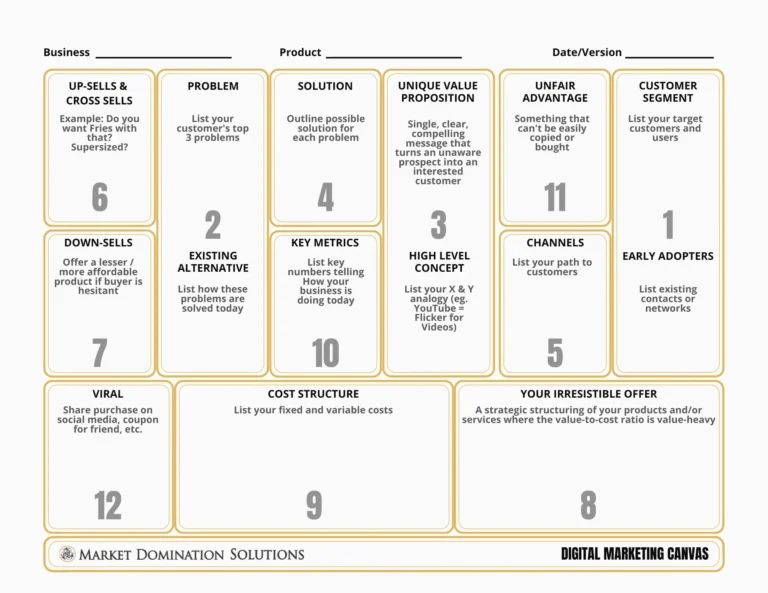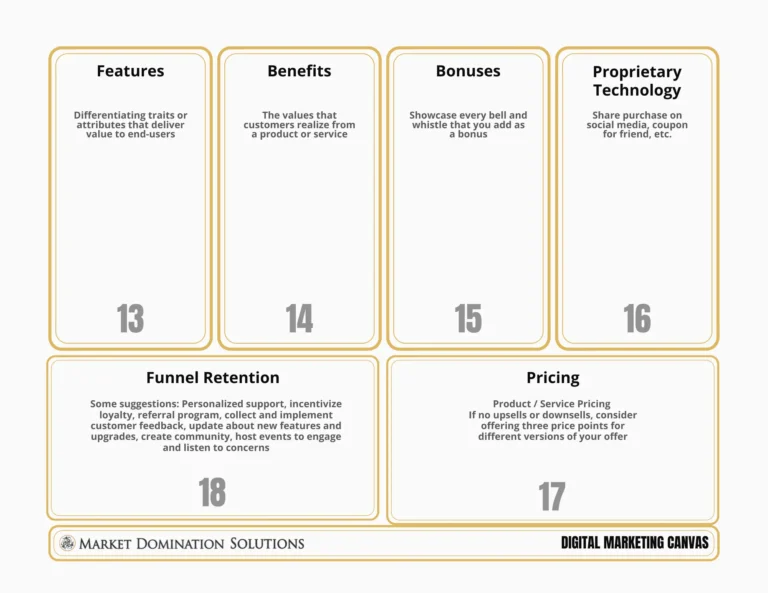My Digital Marketing Canvas
See How My Lean-Canvas Hack
Can Stack Marketing in Your Favor
As an entrepreneur, one of your most critical responsibilities is to translate the ideas that you have in your head into a tangible format so that you can communicate them with others.
Why a Digital Marketing Canvas?
My Digital Marketing Canvas was adapted from Ash Maurya’s Lean Canvas – but it bears little resemblance to it now. I started using the Lean Canvas for product launches 10+ years ago and found that every time I would slow down to fill one out prior to launching a product, I increased my revenue AT LEAST 4X. (I’ve gone back and re-launched products, that’s how I know)
Sometimes I didn’t fill it out until I was ready to create the sales page, but it’s even more effective if I would slow down to do it before I actually created the product. When filled out prior to product creation, we can make more significant adjustments, craft a more popular product, and create a better funnel.
But, for me, as entrepreneur and CEO, the REAL VALUE of the Lean Canvas lies in its simplicity. The boxes are small, and it requires that you focus and be CLEAR.
The result:
- I can walk my team through it quickly, because my ideas are easy to understand – and the resulting brainstorming sessions can be wickedly cool!
- The team can refer back to the sheet for the most important points – we are all on the same page, literally
- All the marketing concepts are there, so a compelling sales page is put together quickly and efficiently
- All the marketing reiterates the same pain and solution points, making for coherent campaigns
By giving your ideas shape and structure, you embody your entrepreneurial vision, and ensure that your audience can connect with your vision and understand it fully.
Because I use these for product launches, I started making modifications to the Lean Canvas form. Over time, it’s become a completely different thing.
Today, I thought I’d share this version with you.
As we go along, I’ll share insight from my experience in “pro tip” areas – here’s the first one:
PRO TIP: The Customer Segment (#1), the Problems (#2), and the Solutions (#4) are intrinsically connected — without a Customer Segment in mind you can’t think of their specific problems and solutions, and visa-versa.
It’s easiest to fill out one sheet for each Customer Segment. This way you can more easily keep track of which problem/solution set goes with which Customer Segment.
Here is a quick explanation of each Lean Canvas block (and in the order to go through them):
1a. Customer Segments
Divide your potential customers into specific groups based on shared characteristics, behaviors or preferences so each group can be more easily understood and targeted.
As you try to decide on segments, consider all the different uses for your product, training, or service and who might find each of these uses most appealing.
PRO TIP: After you have defined your segments, identify which segment is likely to be the most valuable, either because they will purchase more frequently, purchase in a larger volume, or in another way simply spend more money with your company. When you start marketing, you will want to begin by marketing to this segment first. If it works well, this may be the only segment to which you ever market.
1b. Early Adopters
Your early adopters will be those with whom you have an existing direct or indirect relationship – i.e. people who already know, like and trust you. This can be your list of existing contacts, existing relationships with networks, and JV partners.
2a. Problem
Each customer segment you are planning to work with will have a set of problems that they need to have solved. In this box list one to three high priority problems which plagues this Customer Segment. Without a problem to solve, you don’t have a product/service to offer.
Sometimes the problem you think your product is solving isn’t the REAL problem. Sometimes you have to look deeper to understand the real pain your Customer Segment is experiencing. It can be useful to look at competitors’ sales pages to see what problems they are describing and check keyword tools to see which terms have more searches.
2b. Existing Alternative
List how these problems are solved today
3a. Unique Value Proposition
A value proposition is a promise of value to be delivered. It’s the primary reason a prospect should buy from you. Think about why are you different from your competition, and why should this Customer Segment should buy/invest time in you — further reading: Useful Value Proposition Examples (and how to create a good one)
3a. High Level Concept
Similar to an elevator pitch, but even shorter, creating this analogy will give you an effective tool to quickly get your idea across and make it easy to spread. Examples are “YouTube is Flicker for Videos”, or “Aliens (movie) is like Jaws in Space”

With a clear and concise message, you can inspire others to join you on your journey and pave the way for success.
4. Solution
The solution is why you invented your product or service in the first place. There should be at least one solution for each problem you listed.
5. Channels / JV’s
Channels are ways for you to get your message in front of this Customer Segment. Channels can be email, social groups, paid ads, guest blogging, content marketing, live streaming, video marketing, trade shows, radio & TV, webinars etc.
Focus on where THIS Customer Segment hangs out and be specific.
Also consider if it’s appropriate to take advantage of Joint Venture partners (JV’s) or affiliate platforms.
PRO TIP: It’s a good idea at this point to start cultivating relationships with potential JV partners to whom you can be referred by a mutual association.
6. Upsells & Cross Sells
From McDonald’s infamous “Do you want fries with that?” to the stand at the grocery store checkout, upsells and cross sells encourage your customer to add-on or upgrade their original purchase, increasing the overall profit of the sale.
The reason an upsell works is that the visitor is already in purchase mode. And you know that the buyer is interested in the product(s) in their shopping cart, so offering them more of the same frequently results in a larger purchase.
PRO TIP: Make sure credit card information will not need to be re-entered.
An example of an upsell for a training program could be coaching your students through the process the training describes. An upsell for the coaching might be a mastermind or inner circle.
Also, consider products that you have in your arsenal that could be used for upsells. These products should be tightly aligned with the original product offered, but it can also be more broad.
If nothing exists, consider what you could create with little effort that would allow you to capitalize on these benefits. For example, you could bundle all of your training into a single product for an upsell.
Upsells aren’t just for products, I’ve experienced upsells when placing salon appointments and even when making a dentist appointment. Think about what related services you can offer. Especially services that are in less demand, where you might be paying staff that are not at 100% capacity. You could offer these services at a small discount to encourage filling up the calendar for this staff.
PRO TIP: Generally you can have 2-3 upsells in a single funnel, successfully. More than that and you risk losing the sale entirely.
7. Down-sells
A down-sell is offered when the person tries to leave the sales page without purchasing. A popup offers them a smaller product, a free product, or a percentage off the original product offered, or purchase paid over time. At a minimum, a successful down-sell allows you to capture the visitors email address so you can market to them further. At best it turns what would have been a lost sale into a purchase.
Down-sells can also be offered if the upsell isn’t accepted – it can be the upsell paid over time, or a less expensive option.
Again, for this block, consider products that you have in your arsenal that could be used for a down-sell, or what could be created with little or no effort, for example a cheat sheet, or a piece of the original product.
Pro Tip: Don’t get too carried away with upsells and down-sells, or it will cheapen your brand, and your visitor will think you are just in it for the money
8. Your Irresistible Offer
A strategic structuring of your products and/or services where the value-to-cost ratio is value-heavy. This is not about heavily discounting your product, it’s about an offer that is sustainable for your business model, and can continually sell.
Your irresistible offer should communicate the value of your product or service so clearly that anyone in your target market who is considering making a purchase, believes the value will far surpass the cost.
The most effective irresistible offers are the ones that leverage multiple pricing or value strategies.
This is often called creating an “offer stack”. A simplified version of an irresistible offer is a good deal stacked on top of another good deal.
Here are a few of those strategies and methods:
- Bundling
- Value-Adds
- Attention-Grabbing Risk Reversal
- Discounting correctly
For more information about how to structure an irresistible offer, you can grab Mark Joyner’s ebook here or the audiobook here.
9. Cost Structure
Here you should list all the costs for taking this product to market. Also consider any monthly recurring costs or additions to existing costs. For example, if you are running a help desk, estimate the cost of the additional effort needed to support this product.
PRO TIP: You can then use these costs and potential revenue streams to calculate a rough break-even point.
10. Key Metrics
It’s important to map your funnel, from educating your prospects through to purchase. At each stage determine key aspects that will help you understand how well your funnel is working, and where there may be leaks, so you can get them plugged. It’s helpful to have a seasoned marketing veteran help to determine valid key metrics, and help set goals along the way for the first year so you can tell if you are on track to break even or make a profit.
Key Metrics often consists of:
- Website Visitors
- Number of Unique Visitors
- Traffic Source (which marketing is working best)
- Time on Site
- Most Visited Website Pages
- Conversion Rate
- Actions (Goals) Taken Onsite
- Join mailing list
- Download product information
- Purchase product/service
- Revenue: The amount of revenue made over a period of time
- Break Even Point
- Profit
11. Unfair Advantage
This is the most difficult block to answer. “The only real competitive advantage is that which cannot be copied and cannot be bought.” — Jason Cohen. Here is a great definition of unfair advantage: Unfair advantage can be insider information, a dream team, getting expert endorsements, existing customers etc. Think about what you have that no one else can buy. There’s more help for this in Proprietary Technology (block #16)
Leanstack maintains that it’s always better to leave the unfair advantage box blank than stuffing in a weak unfair advantage as a placeholder. But it’s here to make you really think about how you can/will make your business different and make that difference matter.
12. Viral
Consider how this purchase can be made viral. The easiest thing is to offer the purchaser to share their purchase on social media, however, if you can create more virality, perhaps through gamification, then your sales can potentially be multiplied.
13. Features
Products and services all have features. These are usually easy to list. Features are traits or attributes that deliver value to end-users and can differentiate a product in the market. The battery life of an electronic device, for example, can be considered a feature.
14. Benefits
Benefits are the reasons customers buy the product or service. These are typically more difficult to think of than features. Benefits are the values that customers realize from a product or service. These can include ease of use, time saving or even prestige. Start by examining the items in your Solutions column (#4), for benefits, and branch out from there. It’s a great exercise to take each item from your Features column and translate it into one or more benefits.
15. Bonuses
My definition of bonuses is anything beyond the minimum viable product. All of the additional features and benefits can be classified “bonuses”. For example, let’s say you’ve created something that needs a user’s manual to explain it, a bonus can be a video form of the user’s manual. The manual is a requirement, but the video (even if you THINK it’s a requirement – and you were going to do one anyway, is a bonus).
That means every bell and whistle that you are going to add to make your product better, can be showcased as a bonus.
Read down your Features and Benefits columns and move any of the non-essentials over to this column.
16. Proprietary Technology
Everybody has their own way of doing their “thang”. Cleaners have a special way of disinfecting; bed companies have a special way of making you sleep better; beer companies do something special with their ingredients (think Coors); Pizza companies have a special way of keeping their pizza hot; and so on. It doesn’t matter if your company produces a product or offers a service, there are things that you do that are technical, perhaps mundane, and almost assuredly a “behind the scenes” type of action.
Give these actions, processes, or specialties an interesting name. You can simply allude to what the process is, you decide the level of detail – but highlight it as a proprietary technology that only you do. This can then be an item in your “unfair advantage” box.
17. Product / Service Pricing
When considering the pricing of your product / service, if there are no upsells / downsells, then consider having three alternatives. This is due to the “decoy effect”, a cognitive bias that explains how an inferior third option can change how we decide between two options that are similar in value. Here’s more on the decoy effect and how it works.
18. Funnel Retention
It costs far less to keep an existing client than it does to go find new ones. There are many possible avenues to keeping a client and the ones you choose will depend largely on your product. Remember to tweak these options to apply to THIS product. The list you make here will become the framework for your “after purchase roadmap”. Options include
- Regular updates about their status and progress toward goals (service) or new features and upgrades (product)
- Personalized Support
- Incentivize Loyalty
- Referral Program
- Collect and implement Customer Feedback
- Create a Community
- Host Virtual Events to engage and listen to concerns
OK, You’re ready!. Right click and save to download a blank copy of our lean canvas and start to flesh out your plan.
And let me know in the comments what fields you would like to see added or taken away from this worksheet!

Trying to fill in your lean canvas the first time can be tricky. Here’s a sample one to help you wrap your head around it better.


